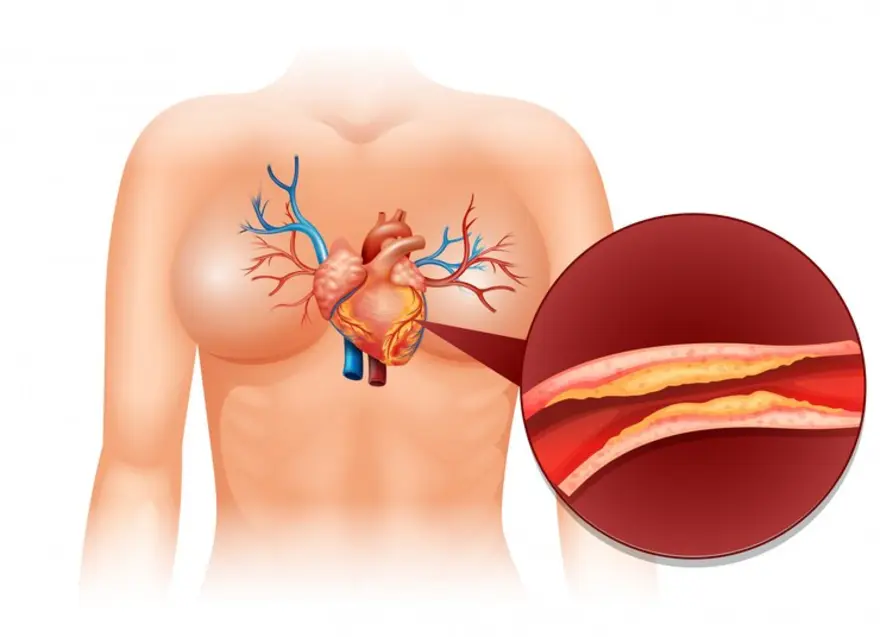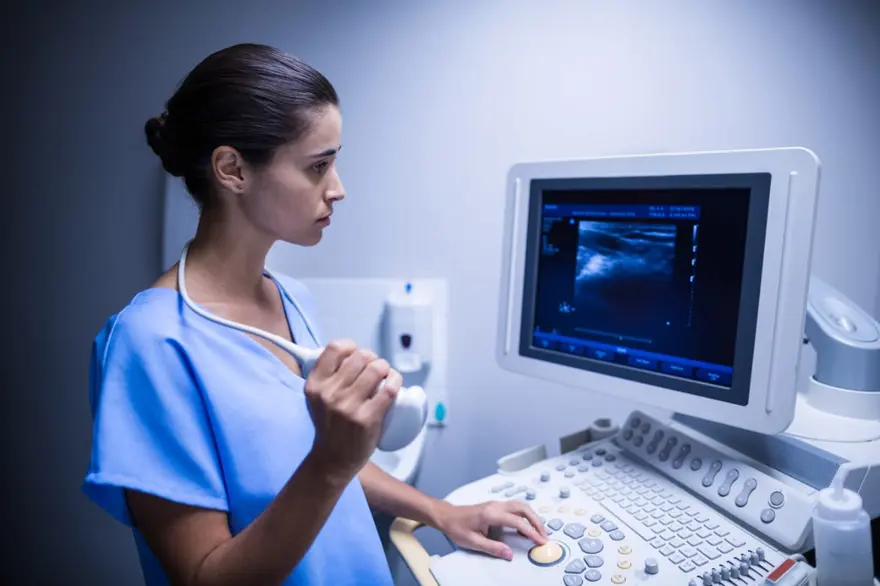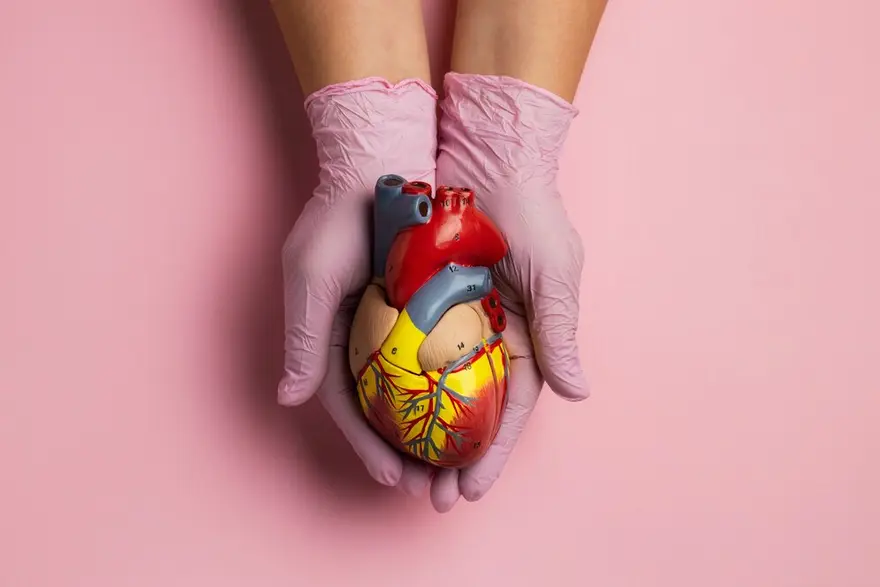Latest Blogs
Understanding Transvaginal Ultrasound: Purpose, Preparation, and Results
Introduction Transvaginal ultrasound is a vital diagnostic tool in women's healthcare that offers detailed insights into pelvic health. This article provides a comprehensive exploration of the procedure, its uses, and benefits in ensuring female reproductive well-being. What is a Transvaginal Ultrasound? A transvaginal ultrasound, also known as endovaginal ultrasound, is a medical procedure utilised to examine female reproductive organs, including the uterus, ovaries, cervix, and fallopian tubes. Unlike a traditional abdominal ultrasound, where the ultrasound wand (transducer) is placed on the abdomen's surface, transvaginal ultrasound involves inserting a probe directly into the vagina for a closer view of the pelvic organs. What is the Difference Between an Ultrasound and a Transvaginal Ultrasound? USG, in its full form, stands for Ultrasonography. It is a broad term referring to the medical imaging technique that uses high-frequency sound waves to create images of internal body structures. It encompasses various types of ultrasound procedures, including abdominal ultrasound and transvaginal ultrasound. While ultrasound uses a non-invasive technique to generate images of internal abdominal structures, transvaginal ultrasound offers superior visualisation and details due to the transducer's proximity to your pelvic organs. When is a Transvaginal Ultrasound Performed? Transvaginal ultrasound is used to investigate the pelvic cavity thoroughly and address various gynaecological concerns such as abnormal bleeding, pelvic pain, and infertility. Another transvaginal ultrasound purpose is to monitor the growth and development of your foetus during pregnancy. When Would a Transvaginal Ultrasound be Needed? The most significant purpose of transvaginal ultrasound is a diagnosis of various gynaecological conditions and reproductive health concerns, like: Endometriosis Evaluation: Endometriosis is a condition where tissue similar to the lining of the uterus may grow outside on your ovaries or other pelvic organs, commonly resulting in chronic pelvic pain or painful periods. A transvaginal ultrasound can help visualise any endometrial implants and adhesions within the pelvic cavity. Ovarian Cyst Assessment: If you suspect ovarian cysts, characterised by pelvic pain or irregular menstruation, you may undergo a transvaginal ultrasound to confirm and assess the size and composition of the cysts. This helps to rule out potential complications such as ovarian rupture, which affects the release and quality of eggs. Polycystic Ovarian Syndrome (PCOS) Diagnosis: Transvaginal ultrasound plays a crucial role in diagnosing PCOS. It reveals the characteristic appearance of multiple small follicles (fluid-filled sacs containing eggs) within the ovaries, along with other associated findings such as increased ovarian volume and thickened ovarian capsules. Uterine Fibroids Detection: For women experiencing symptoms such as heavy menstrual bleeding, pelvic pressure, or frequent urination, a transvaginal ultrasound can identify the presence, size, and location of uterine fibroids, aiding in treatment planning and management decisions. Pelvic Inflammatory Disease (PID) Evaluation: In cases of suspected PID, which may manifest as lower abdominal pain, abnormal vaginal discharge, or fever, a transvaginal ultrasound can detect signs of inflammation or infection within the reproductive organs. This helps in getting treatment promptly to prevent complications such as tubal scarring (formation of scar tissue in the fallopian tube connecting ovaries to the uterus) or infertility. Fertility Issues: For those struggling with infertility, a transvaginal ultrasound may be a part of the diagnostic process to evaluate the health of reproductive organs, assess ovarian reserve (quantity and quality of eggs available for fertilisation), and identify any anatomical abnormalities that could affect fertility. Early Pregnancy: Transvaginal ultrasound pregnancy assessment is commonly performed during the early stages of conception. This procedure aims to confirm the presence of a gestational sac, assess fetal viability, determine gestational age, and detect potential complications such as ectopic pregnancy (fertilised egg implants outside the uterus) or miscarriage. Fetal Development: Throughout pregnancy, transvaginal ultrasounds may be utilised to monitor the growth and development of your foetus, evaluate its anatomy, and detect any abnormalities or developmental issues that may require medical intervention. Who Performs a Transvaginal Ultrasound? Trained sonographers or radiologists typically conduct transvaginal ultrasounds in a medical facility equipped with ultrasound technology. These professionals possess expertise in operating ultrasound equipment and interpreting the obtained images. How Does a Transvaginal Ultrasound Work? During the procedure, your healthcare provider will gently insert a condom-covered lubricated transducer probe into the vagina. This probe emits high-frequency sound waves that penetrate your pelvic organs and surrounding structures, bouncing back to create real-time clear images on a monitor. How Long Does a Transvaginal Ultrasound Take? The duration of a transvaginal ultrasound varies depending on the specific purpose and complexity of the examination. Generally, the procedure lasts between 15 to 30 minutes, although it may be extended if additional evaluations or measurements are necessary. How Do I Prepare for a Transvaginal Ultrasound? Transvaginal ultrasound preparation takes minimal effort from your side. Your healthcare provider may advise you to drink water and avoid urinating before the procedure to ensure a full bladder, which can aid in obtaining clearer images of the pelvic organs. Additionally, wearing comfortable clothing and informing the healthcare provider of any medical conditions or allergies can be considered as part of transvaginal ultrasound preparation. What Should I Expect During a Transvaginal Ultrasound? During the procedure, you'll be asked to lie on your back on an examination table with your feet placed in stirrups, similar to a pelvic exam. The transducer probe will then be gently inserted into your vagina, causing minimal discomfort. The healthcare provider may turn the probe to capture images from various angles while explaining the process and addressing any concerns you may have. Is a Transvaginal Ultrasound Painful? While some individuals may experience slight discomfort or pressure during the insertion of the transducer probe, the procedure is generally well-tolerated and causes minimal pain. The probe is well-lubricated before the insertion, and it bends around your body. This, coupled with the gentle technique employed by your healthcare provider, helps mitigate discomfort. What Are the Risks of a Transvaginal Ultrasound? Unlike the risk of radiation exposure in X-rays, transvaginal ultrasounds are considered safe with minimal associated threats. Rarely some individuals may experience minor vaginal bleeding or irritation following the procedure. However, serious complications are exceedingly rare. What Type of Results Do You Get After a Transvaginal Ultrasound? Following the procedure, the obtained images are interpreted by a radiologist or healthcare provider who analyses the transvaginal ultrasound result and provides a comprehensive report. Depending on the purpose, your transvaginal ultrasound results may include assessments of pelvic organ health, pregnancy viability, foetal development, or identification of abnormalities requiring further evaluation or treatment. Conclusion: In navigating the realm of women's health, understanding procedures like transvaginal ultrasound is crucial for informed decision-making and proactive healthcare management, especially pelvic wellness and pregnancy care. At Metropolis Lab, we prioritise your health and well-being, offering state-of-the-art diagnostic services. Trust in our commitment to delivering accurate results and personalised care, empowering you to prioritise your reproductive health with confidence.
Protein Rich Food For Vegetarians: Sources, Diet Plan & Food Chart
Overview As a vegetarian, you have chosen a path that is compassionate and incredibly healthy. However, are your nutritional needs, especially protein, really being met? Protein is a nutrient that helps build and repair tissues, supports your immune system, and keeps you feeling full and energised. Women should aim for at least 46 grams of protein per day, while men should target around 56 grams. However, your protein needs may vary depending on your weight and activity level. As meat is the go-to source of protein for many, as vegetarians, you may have heard of concerns about meeting your protein needs, but do not fear! Here, you have a diverse array of protein rich food veg at your fingertips. Let’s look into the veg protein food chart and enrich our knowledge of veg protein sources. Protein Rich Food For Vegetarians Eating a protein rich vegetarian diet offers several health benefits compared to meat-based protein. Plant-based protein is lower in saturated fat and cholesterol, making it a heart-healthier option. They contain more fibre, vitamins, minerals, and antioxidants, which contribute to overall health by helping you reduce your body weight. It also reduces the risk of chronic diseases such as heart disease, diabetes, and cancer. Here’s a list of veg protein sources waiting to fuel your journey towards optimal health. Let’s check the protein rich food veg: Lentils Lentils or dals are a staple in every Indian kitchen. With 18 grams of protein per cooked cup (198 grams), they are a very good source of protein and fibre. Legumes Beans, chickpeas, and peas are excellent sources of protein and fibre. Every cooked cup of legumes contains 18 grams of protein. Whether you enjoy them in soups, salads, or curries, legumes are a nutritional addition to any meal. Nuts Almonds, walnuts, and cashews are not only crunchy and delicious but also rich in protein and healthy fats. Every 28 grams of nuts contains 5 to 7 grams of protein based on the variety of nuts. Sprinkle them over the salad or enjoy them as snacks between the meals. Soy Milk Soy milk is a great alternative to dairy milk. It is fortified with calcium and protein, making it a valuable addition to your diet. It contains 6 grams of protein per cup, which is 244 grams of soy milk. Pour it over your morning cereal, or use it in smoothies for an extra protein boost. Green Peas Do not underestimate the nutritional power of these vibrant green gems. They are excellent vegetable protein sources, with around 9 grams of protein per 160 grams of cooked cup of peas. They are a tasty way to sneak in some extra protein. Quinoa Often hailed as a superfood, quinoa is a complete protein, meaning it contains all nine essential amino acids. Quinoa contains 8 to 9 grams of protein per cooked cup (185 grams). Swap out rice or pasta for quinoa in your favourite dishes to up your protein intake. Chia Seeds These tiny seeds are packed with protein, fibre, and omega-3 fatty acids. They contain 5 grams of protein and 10 grams of fibre per 28 grams of chia seeds. Add them to your yoghurt, oatmeal, or smoothies for an extra nutritional boost. Oats Starting your day with a hearty bowl of oatmeal not only provides you with sustained energy but also a good dose of protein. 40 grams of oats contain 5 grams of protein and 4 grams of fibre. Customise your oats with fruits, nuts, and seeds for a nutritious breakfast. High Protein Vegetables Broccoli, spinach, and kale are not only rich in vitamins and minerals but also surprisingly high in protein. It contains 4 to 5 grams of protein per cooked cup. Incorporate them into your meals to add nutritional value and flavour. Fruits While not as protein-dense as other foods on this list, fruits like guava, bananas, and avocados still contribute to your overall protein intake. They contain around 2 to 4 grams of protein per cup. Plus, they’re packed with vitamins, minerals, and antioxidants. Edamame These young soybeans are not only delicious but also excellent veg protein sources. They contain 10 to 12 grams of protein per 100-gram serving. Enjoy them steamed as a snack or added to salads and stir-fries. Brussels Sprouts These miniature cabbages are not only cute but also nutritious. With approximately 4 to 5 grams of protein per cooked cup, Brussels sprouts are a great addition to any meal. Wild Rice Unlike white rice, wild rice is not stripped of its bran. It is higher in protein and fibre, making it a healthier choice for vegetarians. The cooked cup (approx. 100 grams) of wild rice contains nearly 4 grams of protein. Use it as a base for grain bowls for a satisfying meal. Sweet Corn Bursting with sweetness and flavour, sweet corn is a summertime favourite and a good source of protein. 100 grams of sweet corn contains 3.2 grams of protein. Enjoy it grilled, steamed, or tossed into salads and salsas. Cottage Cheese If you include dairy in your diet, cottage cheese is an excellent source of protein. Every 100 grams of cottage cheese contains around 11 grams of protein. Enjoy it on its own, or mix it with fruits and vegetables. FAQs: How do Vegetarians Get Enough Protein? You can easily meet your protein needs by incorporating a variety of protein rich food veg into your vegetarian diet plan, such as legumes, nuts, seeds, and whole grains. Be sure to include veg protein sources at each meal to ensure adequate intake. Which Fruit Has the Most Protein? While fruits are not typically high in protein compared to other food groups, guava stands out as one of the highest-protein fruits, with approximately 2.6 grams of protein per 100-gram cup. Do Vegetarians Lose Weight Faster? A vegetarian diet plan can be conducive to weight loss due to its high protein content, lower calories, and reduced saturated fat. Veg protein sources can help reduce weight by making you feel satiated, boosting metabolism, preserving muscle mass, regulating appetite hormones, and promoting fat loss. However, weight loss also depends on factors such as overall calorie intake, food choices, and the extent of physical activities to break down fat or calories consumed. Which Dal is High in Protein? Among dals (lentils), moong dal (split green gram) is one of the highest in protein, offering approximately 14 grams of protein per cooked cup. Which Vegetable Has the Most Protein? Spinach and broccoli are among the vegetables with relatively higher protein content, around 2.9 grams per 100-gram serving. As a Vegetarian, How Can I Get 75 Grams of Protein a Day? Your vegetarian diet plan should include a variety of protein rich food veg options, such as lentils, legumes, tofu, nuts, seeds, quinoa, and dairy alternatives. What is the Best Source of Protein for Vegetarians? Legumes, tofu, tempeh (fermented soybeans), nuts, seeds, quinoa, cottage cheese, whey protein, skim milk, etc. are excellent veg protein sources.
Everything You Need to Know About Bartholin Cysts
What is a Bartholin cyst? A Bartholin cyst is a fairly painless lump that forms near the vagina; it can be found on either side of your labia (lips of the vagina). This cyst is named after two small glands that are present in the area and help produce the fluid required to lubricate your vagina. The Bartholin glands and labia are part of the vulva. A Bartholin cyst is usually present on only one of the two glands. While some are smaller and do not cause much pain, larger Bartholin cysts, especially those that get bacterial infections, may be painful and need medical treatment. What does a Bartholin cyst look like? A Bartholin cyst usually appears as a small round bump under the skin of the labia. If there is an infection, some may turn red, swollen, and tender, and at other times, the Bartholin cyst can fill with fluid or pus. The size of Bartholin cysts can range from small pea-sized bumps to large gold ball-sized cysts that can sometimes make the labia look lopsided and larger on one side. Who gets Bartholin cysts? About 2% of women are believed to have developed a Bartholin cyst at some point in their lives. Bartholin cysts are more common in women of reproductive age, and the chances of developing one can decrease considerably after menopause. What causes a Bartholin cyst? The reason why some women are predisposed to developing Bartholin cysts is still unknown to most healthcare providers; however, commonly known Bartholin cyst causes include: Bacterial infections like E-coli Sexually transmitted diseases such as gonorrhea and chlamydia Irritation, injury, or growth of extra skin near the vulva region What are the symptoms of a Bartholin cyst? Most Bartholin cysts are small and may not cause many symptoms except minor irritation. However, if these Bartholin cysts grow in size and become infected or form an abscess, the following symptoms may occur: Swelling and tenderness in the area Discomfort and pain during sex, while using a tampon, sitting, walking, or when wiping after using the restroom Redness Fever and chills Changes in the size of the cyst Drainage of fluid/pus from the cyst Is a Bartholin cyst contagious? Most Bartholin cyst cases are minor and do not get infected or spread through skin-to-skin contact. However, one of the leading Bartholin cyst causes is sexually transmitted diseases, which can be contagious. Does an infection cause Bartholin cysts? Bartholin cyst causes include bacterial infections such as E. Coli and sexually transmitted diseases. These infections can clog the Bartholin gland, leading to the formation of the Bartholin cyst. How is a Bartholin cyst diagnosed? Your healthcare provider/gynaecologist will perform a physical examination to check the size of the Bartholin cyst and whether it is showing any signs of infection. If a discharge is oozing out of the cyst, this fluid will also be tested for sexually transmitted infections or other forms of bacterial infections. What tests are done to diagnose Bartholin cysts? Women older than 40 may need to undergo a biopsy on the Bartholin cyst to rule out cases of vulva cancer. For this test, your doctor will take a small tissue sample from the Bartholin cyst and examine it under a microscope. If the Bartholin cyst is found to be cancerous, it may need to be surgically removed. However, the Bartholin cyst rarely develops into cancer, which is often more common after the age of 60. What are the treatments for a Bartholin cyst? Bartholin cyst treatment options vary based on the symptoms you are displaying. Smaller, painless Bartholin cysts may not even need any form of treatment. However, if it starts to grow or the symptoms persist, you may develop an infection or abscess requiring treatment or, in severe cases, Bartholin cyst removal. Bartholin cyst treatment options include: Sitz Baths: For a few days, you will need to sit in a bathtub with a few inches of warm water several times a day to give you comfort from Bartholin cyst symptoms and promote healing. The warm water also aids in bursting and draining the Bartholin cyst. Over-the-counter medication: This helps relieve pain and discomfort caused by the Bartholin cyst. Antibiotics: These may be prescribed to treat any bacterial or sexually transmitted infection that may have that causes the Bartholin cyst. Surgical draining: Bartholin cyst surgery is often performed on large and infected cysts to drain the fluid inside. It is carried out with a small tube known as a catheter inserted into the cyst. Marsupialization: This is another Bartholin cyst procedure in which the cyst is surgically opened and drained. The ends of the cyst walls are then stitched together to form a pocket or pouch that aids in continuous drainage. Bartholin Gland removal: This is a rare Bartholin cyst treatment option in which the glands may need to be surgically removed because other treatments have failed. Do Bartholin cysts go away on their own? In most cases, Bartholin cysts can disappear on their own. Sometimes they can even burst and deflate on their own. As long as you keep the area clean and dry to avoid the spread of the infection and avoid squeezing or draining the Bartholin cyst, you can manage the symptoms with just sitz baths. How long does a Bartholin cyst last? In most cases, a Bartholin cyst infection may be wholly resolved in a few weeks. However, this may also depend upon the size of the Bartholin cyst and the severity of the infection. Conclusion If you notice a lump near your vagina that can be painful, see your doctor to check for an infection and determine if it's a Bartholin cyst. Talking freely about the infection and asking questions will help your doctor diagnose and treat the condition more effectively. Regular diagnostic tests and health check-ups can also help reduce the chances of Bartholin cysts, infections or sexually transmitted diseases causing added complications. Metropolis Labs provides at-home diagnostic tests for their customer's convenience while maintaining the patient's anonymity. Contact us today for more details.
Exploring Rectal Prolapse: Symptoms, Causes, and Treatment
Rectal prolapse can be uncomfortable to deal with; therefore, understanding the symptoms and complications associated with it is necessary. This guide discusses rectal prolapse in detail, offering insights on treatment options and prevention strategies to help you navigate its challenges effectively. What is rectal prolapse? Rectal prolapse is a condition which occurs when your rectum, the last part of the large intestine, protrudes through your anus. This can lead to discomfort, pain, and difficulty with bowel movements. Rectal prolapse types can include partial, complete, internal, or external, depending on the anatomy of the prolapse. What causes rectal prolapse? Rectal prolapse is primarily caused by weakened pelvic floor muscles and tissues that support your rectum. Chronic straining during bowel movements due to constipation, long-term diarrhoea, ageing, childbirth, or previous pelvic surgery are common rectal prolapse causes. Other factors include neurological conditions, genetic predisposition, and certain connective tissue disorders. What does rectal prolapse look like? Rectal prolapse may look like a reddish or pinkish mass emerging from your anus, typically when exerting pressure during bowel movements. This mass may retract back into the anus or remain visible externally. What are the signs or symptoms of rectal prolapse? Common rectal prolapse symptoms include: The most noticeable rectal prolapse symptom is the protrusion of your rectum through your anus during bowel movements or even when standing or walking. You may experience discomfort, pain, or a feeling of fullness in your rectum or anus. Rectal prolapse can lead to difficulty with your bowel movements, including straining or incomplete evacuation. You may experience leakage of faeces or mucus from the protruding rectum. The exposed rectal tissue can become irritated, leading to itching, burning, or bleeding. You may feel increased pressure or heaviness in your pelvic area, especially when standing or sitting for a long time. How is rectal prolapse diagnosed? Rectal Prolapse diagnosis typically involves: Physical examination: A healthcare provider will perform a physical examination, including a visual inspection of your anus and rectum, to look for signs of prolapse. Digital rectal exam: This involves inserting a gloved, lubricated finger into the rectum to assess the extent of prolapse and check for any abnormalities. Colonoscopy or sigmoidoscopy: These procedures allow for a more detailed examination of the rectum and colon to rule out other potential causes of rectal prolapse symptoms. Imaging tests: In some cases, imaging tests such as MRI or defecography may be ordered to evaluate pelvic floor function and assess the severity of prolapse. Anorectal manometry: This test measures pressure and function in the rectum and anal sphincters, helping to assess bowel function and pelvic floor coordination. Will rectal prolapse go away on its own? Rectal prolapse typically does not resolve on its own and often requires medical intervention, lifestyle changes, pelvic floor exercises, or surgery, depending on the severity of the condition. What happens if rectal prolapse is left untreated? If left untreated, rectal prolapse can cause chronic pain, fecal incontinence, and difficulty passing stool. In severe cases, tissue damage, ulceration and even strangulation of prolapsed tissue can occur, requiring emergency surgery to prevent complications such as tissue necrosis. How do you fix rectal prolapse? Rectal prolapse treatments vary depending on the severity of the condition and individual factors. They include: Abdominal approach (Rectopexy) Rectopexy is a surgical procedure commonly used for rectal prolapse treatment, particularly when the prolapse is significant or associated with other pelvic floor disorders. Rectopexy via the abdominal approach, i.e. through an incision in the belly, is often effective in providing long-term relief from rectal prolapse symptoms. Compared to some other surgical techniques, it lowers the risk of recurrence. Rectal Approach (Perineal) The perineal approach, also known as perineal recto sigmoidectomy or Delorme's procedure, is another surgical option for rectal prolapse therapies. Unlike rectopexy, which is performed through an abdominal incision, the perineal approach involves accessing the rectum through the area between the anus and the genitalia (the perineum). The perineal approach is often preferred for patients who are not candidates for abdominal surgery due to factors such as advanced age, poor overall health, or previous abdominal surgeries. Other options for rectal prolapse therapies include: Conservative management Dietary changes to regulate bowel movements. Pelvic floor exercises to strengthen muscles. Medications to alleviate constipation or diarrhoea. Medical procedures Manual reduction: Non-surgical manipulation to push the prolapse back into place. Rubber band ligation: Placing bands around the prolapsed tissue to cut off its blood supply, causing it to shrink and fall off. Injection sclerotherapy: Injecting a chemical solution into the prolapsed tissue to shrink it. Biofeedback therapy: Training to improve bowel control and pelvic floor function. What are the possible risks or complications of rectal prolapse surgery? Infection: Surgical procedures carry a risk of infection at the incision site or within the pelvic cavity. Bleeding: Post-operative bleeding can occur, either externally from the surgical site or internally within the abdomen or pelvis. Anaesthesia complications: Reactions to anaesthesia, though rare, can include respiratory problems, allergic reactions, or adverse drug interactions. Urinary problems: Surgery near the bladder or urethra can lead to urinary retention, incontinence, or urinary tract infections. Bowel dysfunction: Following rectal prolapse surgery, you may experience changes in bowel habits, including constipation or diarrhoea. Recurrence: Despite surgical intervention, rectal prolapse may recur in some cases, necessitating further treatment. How can I prevent rectal prolapse? Obesity can increase the risk of rectal prolapse, so aim to maintain a healthy weight through a balanced diet and regular exercise Avoid straining during bowel movements Address constipation promptly with dietary changes, fibre supplements, or stool softeners Strengthen pelvic floor muscles with exercises like Kegels to help support the rectum and prevent prolapse If you have a chronic cough, seek treatment to reduce strain on the pelvic floor and rectum Avoid heavy lifting. What is the outlook if I have rectal prolapse? While surgery generally offers favourable outcomes for rectal prolapse, you may experience ongoing symptoms like constipation or incomplete bowel movements. With appropriate medical management or surgery, many people experience significant improvement in symptoms and quality of life, with a low risk of recurrence. Conclusion In conclusion, rectal prolapse is a condition that can significantly impact your daily life. Still, with prompt diagnosis, appropriate treatment and lifestyle modifications, you can find relief and achieve improved long-term outcomes. If you or your family members want to protect yourself from rectal prolapse and its associated complications, get your blood and stool regularly tested at Metropolis Healthcare for timely diagnosis. Metropolis Healthcare strives to provide best-in-class diagnostic service that is not only reliable but also pocket-friendly, executed by the best phlebotomists, and trusted by the best doctors across the country. Hurry up and book your test today!
Understanding Tinea Versicolor: Symptoms, Causes, and Treatment
What is tinea versicolor? Tinea versicolor, a prevalent skin fungal infection, which disrupts natural skin pigmentation, leading to small, discoloured patches. Tinea versicolor commonly affects the torso and upper arms but can also appear on the face and neck, especially in younger children. The tinea versicolor on face can appear to be white, brown, red, or pink in colour or a dry, flaky, or scaly skin with a flat or slightly raised texture. What does tinea versicolor look like? Tinea versicolor spots can manifest as patches that are either lighter or darker than the surrounding skin, presenting in hues of white, pink, or light brown. These patches may exhibit dryness or scaliness and tend to appear more prominently on the chest and shoulders. Who gets tinea versicolor? Tinea versicolor can affect anyone, but it's more common in adolescents and young adults. Tinea versicolor can affect people worldwide, regardless of geographic location or nationality. However, it may be more commonly reported in regions with warm and humid climates, where the conditions are conducive to fungal growth on the skin. What are the symptoms of tinea versicolor? Most individuals experience mild tinea versicolor symptoms such as: Skin discolouration, typically on the back, chest, and abdomen. Discoloured patches can occur anywhere on the body and vary in shades of pink, yellow, brown, tan, or white. Itching in or around the affected skin areas. Increased sweating. Areas of skin that may become dry and develop scales. Skin patches that fail to darken or tan when exposed to sunlight. What causes tinea versicolor? Major cause of tinea versicolor is an excessive proliferation of yeast on the skin's surface. Flourishing in warm, moist, and oily conditions, this yeast multiplies in small clusters, leading to the characteristic symptoms of the condition. Tinea versicolor causes are as follows: Compromised immune function. High temperatures and humidity. Perspiration. Excessively oily skin. Hormonal fluctuations. How is tinea versicolor diagnosed? Tinea versicolor is typically diagnosed through a combination of medical history review and physical examination. The distinctive patches associated with this condition often facilitate its identification during the physical examination. Additionally, healthcare providers may utilise a Woods Lamp, an ultraviolet light, to enhance the visibility of the patches for a clearer diagnosis. How is tinea versicolor treated? The following ways can be considered for tinea versicolor treatment: Over-the-counter antifungal medication For mild cases, over-the-counter antifungal lotions, creams, ointments, or shampoos can be applied as an easily and accessible tinea versicolor treatment options. Prescription antifungal medication Clotrimazole cream or lotion Miconazole cream Selenium sulphide lotion Terbinafine cream or gel Zinc pyrithione soap Other ways of treatment are as follows: Severe or unresponsive cases of tinea versicolor may require prescription-strength medication. Medications may include: Ketoconazole cream, gel, or shampoo Ciclopirox cream, gel, or shampoo Fluconazole tablets or oral solution Itraconazole tablets, capsules, or oral solution Selenium sulphide lotion or shampoo Preventative medication may be necessary once or twice a month for persistent cases. How can I treat tinea versicolor at home? Home Remedies for Tinea Versicolor: Natural Antifungal Agents: Tea tree oil and apple cider vinegar possess antifungal properties that can help combat the fungal infection responsible for tinea versicolor. Tea tree oil can be diluted with carrier oil and applied directly to the affected areas, while apple cider vinegar can be diluted with water and applied as a topical solution. Yogurt and Honey Mixture: Yogurt contains probiotics that can help restore the balance of microorganisms on the skin, while honey has antimicrobial properties. Mixing yoghurt and honey into a paste and applying it to the affected areas can help soothe the skin and inhibit fungal growth. Aloe Vera Gel: Aloe vera gel is known for its soothing and healing properties. Applying pure aloe vera gel on the affected areas can help reduce inflammation, soothe irritated skin, and promote healing. Coconut Oil: Coconut oil has antifungal properties and can help combat the fungal infection causing tinea versicolor. Applying coconut oil to the affected areas can help moisturize the skin, reduce dryness, and prevent fungal growth. Maintain Good Hygiene: Keeping the affected area clean and dry is essential for managing tinea versicolor. Regularly washing the skin with a gentle cleanser and patting it dry can help prevent the growth of fungi and reduce the risk of infection. Remember that it is good to get in touch with the doctor before you follow any remedies at home. How long does tinea versicolor take to go away? Treatment for tinea versicolor typically takes around 1-2 weeks to show improvement. If tinea versicolor recurs, you should consult a healthcare professional for further evaluation and management. How can I prevent tinea versicolor? Preventing a recurrence of tinea versicolor can pose challenges. However, if you've been diagnosed with and successfully treated the condition, there are proactive measures you can take to reduce the likelihood of future infections: Avoiding prolonged exposure to excessive heat. Steer clear of tanning or extended periods of sun exposure. Minimise excessive sweating by staying cool and wearing breathable clothing. Utilise prescription-strength skin treatments during periods of increased susceptibility to tinea versicolor. What are the risk factors for developing tinea versicolor? Several environmental and biological factors can elevate your susceptibility to this condition, including: A familial predisposition to tinea versicolor. Excessive perspiration. Residence in a humid, warm environment. Weakened immune function. Use of immunosuppressive medications. Certain types of cancer. Can tinea versicolor come back? Yes, it can return even after successful tinea versicolor treatment. Tinea versicolor can recur due to factors like dormant fungal spores, warm and humid environments, individual susceptibility, incomplete treatment, weakened immune function, and lifestyle habits. What are the complications of tinea versicolor? Complications of tinea versicolor are generally minimal but may include: Persistent changes in skin pigmentation, lead to uneven skin tone. Recurrence of the infection, requiring further treatment. Emotional distress or self-esteem issues due to changes in appearance. Conclusion Tinea versicolor is a prevalent fungal skin infection characterised by discoloured patches and mild tinea versicolor symptoms like itching and increased perspiration. Diagnosis involves physical examination and tinea versicolor treatment. Options range from prescription medications to over-the-counter remedies. Recurrences are possible, underscoring the importance of preventive measures such as avoiding excessive heat and sun exposure. While complications are usually minor, changes in skin pigmentation and emotional distress can occur.
Understanding Umbilical Hernia: Symptoms, Causes, and Treatment
Umbilical hernias, though often overlooked, can significantly impact one's health and quality of life. These painless protrusions near the belly button, especially in infants, can arise from various factors, including congenital weakness and increased abdominal pressure. While they may seem innocuous, rarely causing any issues, umbilical hernias can turn complicated if the tissues get incarcerated or strangulated. This comprehensive guide delves into the intricacies of umbilical hernias, offering valuable insights to empower individuals in their health journey. What is an umbilical hernia? An umbilical hernia is a bulge or lump under the belly button that occurs when part of the intestine pushes through the abdominal wall. It is more common in babies who are born prematurely or with a low birth weight. An umbilical hernia is most common in babies and infants younger than 6 months old, affecting about 20% of them. It is usually painless and rarely causes any problems. However, medical intervention is advised if the umbilical hernia appears in adulthood. What causes umbilical hernias? An infant umbilical hernia occurs when the muscles around the belly button do not close completely after the umbilical cord is cut after birth. Tissue from the intestines pushes through this abnormal opening. In adults, the umbilical hernia can occur when the abdominal wall is weak. Female umbilical hernia is more common than in males. It appears when fatty tissue or part of the bowel pokes through an area near your navel. Umbilical hernia in adults is mostly caused by weakened abdominal walls due to several pregnancies, obesity, and belly surgeries. What are the symptoms of an umbilical hernia? An umbilical hernia is a bulge or swelling in your belly button area that occurs when abdominal contents, such as fat or intestine, protrude through the defectively closed umbilical opening. Umbilical hernia symptoms in babies include: A bulge or swelling that may be more noticeable when a baby cries, coughs, or strains Swelling that may get smaller or go away when a baby relaxes or rests on its back Umbilical hernia symptoms in adults include: Pain, especially when coughing, sneezing, or lifting heavy objects Bloating or constipation What are the risk factors of an umbilical hernia? Several factors can increase the risk of developing an umbilical hernia, including: Age: Umbilical hernias are most common in infants, especially those born prematurely or with low birth weight. Having several pregnancies: In adults, females are more prone to herniation as multiple pregnancies can weaken the abdominal muscles. Previous surgery in the abdominal area: Abdominal surgeries in adults can also weaken the abdominal wall, making it easier for hernias to occur. Being overweight or obese: Excess weight increases pressure on the abdomen, leading to a higher risk of hernias. Build-up of fluid in the abdominal cavity (ascites): Accumulation of fluid in your abdomen can increase intra-abdominal pressure, contributing to the development of hernias. Receiving long-term dialysis through the abdomen (peritoneal dialysis): Continuous infusion of dialysis fluid into your abdomen can increase intra-abdominal pressure, potentially leading to hernias. How do doctors diagnose umbilical hernias? Doctors diagnose umbilical hernias through a combination of physical examination, medical history review, and sometimes imaging studies. Here is how they typically do umbilical hernia diagnosis: Physical Examination: Doctors visually inspect and palpate the abdomen, focusing on the belly button area for a noticeable bulge or lump, a typical sign of an umbilical hernia. They may also ask you to cough or strain to assess hernia prominence. Observation: Infant umbilical hernias are often diagnosed through physical examination alone due to their straightforward identification. They typically resolve without intervention by ages 4 to 5. Medical History Review: In adults, inquiries about symptoms, pain levels, and potential contributing factors like obesity or pregnancy aid in diagnosis. Imaging Studies: If uncertainty persists or complications are suspected, ultrasound or CT scans are used to confirm the hernia's presence and evaluate its size and prognosis. What are the complications associated with umbilical hernias? Complications of umbilical hernia may include: Incarceration: When abdominal tissue becomes trapped and cannot be pushed back into the abdominal cavity, it causes discomfort or pain; immediate medical attention is needed to prevent further issues. Strangulation: In severe cases, compromised blood supply to herniated tissue can lead to strangulation, a medical emergency requiring surgical intervention to prevent tissue damage. Gangrene and Infections: Although very rarely, an incarcerated or strangulated hernia can contract infections, risking gangrene. In such cases, immediate medical attention is advised. What are the treatment options for an umbilical hernia? Umbilical hernia treatment options include: Watchful Waiting: If an infant's umbilical hernia is small and asymptomatic, doctors may opt for a wait-and-watch approach, as many hernias resolve on their own by the age of 4 or 5. Lifestyle Modifications: For umbilical hernia in adults with small, reducible hernias and no significant symptoms, lifestyle changes such as weight loss and avoiding heavy lifting may help manage your condition and prevent complications. Surgical Repair: Surgery is the primary approach for large or symptomatic umbilical hernias in adults and children. It is also recommended for hernias that do not reduce on their own or pose risks of complications like strangulation or incarceration. Minimally Invasive Surgery: You may opt for laparoscopic or robotic-assisted techniques for hernia repair, offering smaller incisions, faster recovery time, and reduced postoperative pain compared to traditional open surgery for umbilical hernia treatment in adults. What is the outlook for umbilical hernias? The outlook for umbilical hernias is generally positive, especially in infants and children. Here is a summary: Infants and Children: Most infant umbilical hernias close spontaneously by age 2 without treatment. Pediatric hernias usually resolve without intervention, with surgery recommended only if the hernia persists beyond age 4 or 5 or causes complications. Adults: Surgical repair is successful for umbilical hernias in adults, with low recurrence rates, especially in healthy individuals. Minimally invasive techniques like laparoscopic or robotic-assisted surgery offer quicker recovery and fewer complications. Complications: While rare, complications such as strangulation or incarceration require immediate medical attention. Timely surgical intervention effectively resolves these issues and prevents further issues. Conclusion Understanding umbilical hernias is crucial for effective health management. Although they hardly cause any issues, hernias tend to turn painful and complicated if neglected. Therefore, you are always advised to keep a keen eye on umbilical hernia that may start appearing swollen and red and cause pain. In such cases, see your doctor to plan a line of treatment. By staying informed and seeking timely care, individuals can effectively manage umbilical hernias and maintain overall well-being. For accurate diagnosis and comprehensive health check-ups, consider Metropolis Labs, offering convenient at-home sample collection and online report access through the Metropolis TruHealth app.
Patent Ductus Arteriosus (PDA): Symptoms, Causes, and Effective Treatment
What is patent ductus arteriosus (PDA)? A congenital heart defect, Patent Ductus Arteriosus (PDA) is a lasting opening between the heart's major blood vessels. During foetal development, a ductus arteriosus naturally exists but typically closes after birth. If this persists, it becomes a patent ductus arteriosus. What does the ductus arteriosus do? While a minor patent ductus arteriosus may be benign, an untreated large one can lead to the improper flow of oxygen-poor blood. This misdirection poses risks, potentially weakening the heart muscle and triggering complications like heart failure. What happens in babies with patent ductus arteriosus? Babies with patent ductus arteriosus (PDA) have an ongoing connection between major heart vessels, causing excess blood flow away from the lungs. This condition arises when the fetal ductus arteriosus fails to close post-birth. Symptoms in each infant vary based on the opening's size and may include rapid breathing, poor weight gain, and feeding difficulties. Who does PDA affect? PDA predominates among premature infants and afflicts twice as many girls as boys. It's prevalent in babies with neonatal respiratory distress syndrome, genetic disorders like Down syndrome, and those whose mothers contracted rubella (German measles) during pregnancy. How common is PDA? Patent Ductus Arteriosus (PDA) is a common heart condition in newborns, making up 5–10% of congenital heart diseases in term infants. It is more prevalent among premature infants and is twice as common in girls compared to boys. How does PDA affect my baby? The impact of Patent Ductus Arteriosus (PDA) on your baby involves abnormal blood flow between the heart's major vessels. Although a small PDA may not pose immediate problems, a larger one can lead to improper circulation of oxygen-poor blood, potentially weakening the heart muscle and causing complications such as heart failure. What causes patent ductus arteriosus? The causes of Patent Ductus Arteriosus (PDA) remain unknown, with notable associations: Premature infants may have underdeveloped muscles in the ductus arteriosus, hindering natural closure. Genetic abnormalities, such as Down Syndrome, are linked to PDA. In premature births: Muscular underdevelopment in the ductus arteriosus can prevent self-closure. Mothers with German measles during pregnancy are more likely to have babies with heart defects, including PDA. What are patent ductus arteriosus symptoms? Symptoms of patent ductus arteriosus vary based on the type: Small PDAs may be asymptomatic, except for the presence of a heart murmur. Larger PDAs may manifest as: Rapid breathing. Shortness of breath (dyspnea). Sweating during feedings. Fatigue or tiredness. Feeding and eating difficulties. Poor weight gain or growth. Fast pulse or heart rate. How do healthcare providers diagnose PDA? Doctors diagnose patent ductus arteriosus (PDA) through various methods. They typically begin with a physical examination, listening for characteristic heart murmurs and reports from echocardiography and chest x-ray reports. In certain cases, cardiac catheterization provides direct visualisation of the ductus arteriosus and evaluates its size and blood flow patterns. What tests do providers use to diagnose patent ductus arteriosus? Healthcare providers diagnose Patent Ductus Arteriosus (PDA) through a multi-step approach, including: Auscultation: Listening for a heart murmur using a stethoscope. Pulse and Blood Pressure Evaluation: Checking pulse rate and blood pressure. Clinical Assessment: Examining for signs of lung congestion and conducting a thorough physical examination. Echocardiogram: Echocardiogram helps to diagnose the problem by checking the heart's structure and blood flow. Additional Tests: Depending on the situation, health providers may ask you to get supplementary tests done like chest X-rays, electrocardiograms (EKG), and blood tests to get more comprehensive diagnostic information. Do healthcare providers diagnose PDA in adults? In adults, healthcare providers sometimes find patent ductus arteriosus (PDA). It's not common but can be discovered during regular check-ups or echocardiography tests. A distinct continuous murmur often signals the presence of PDA, heard at the upper left side of the chest. How do healthcare providers treat PDA? PDA is treated by the following ways: Monitoring: Small PDAs may be regularly observed without immediate intervention. Medications: Indomethacin or ibuprofen might be prescribed to help ductus arteriosus closure. Surgery: Larger or persistent PDAs may require surgical intervention, such as tying off the ductus arteriosus or employing other surgical techniques to close the opening. Catheterization: Minimally invasive procedures like catheterization may be utilised to place a device that closes the PDA. What medications do providers use to treat PDA? Healthcare providers may employ medications to address Patent Ductus Arteriosus (PDA), with common choices being: Indomethacin: A nonsteroidal anti-inflammatory drug (NSAID) that aids ductus arteriosus closure by reducing prostaglandin production. Ibuprofen: Another NSAID, similar to indomethacin, used to stimulate the closure of the ductus arteriosus. Prostaglandins may be used to maintain ductus arteriosus patency until surgical ligation is performed. Intravenous (IV) indomethacin or IV ibuprofen is used for treating PDA in neonates and premature infants. What are other types of patent ductus arteriosus treatment? Healthy Lifestyle: Maintaining overall cardiovascular health through a healthy diet and avoiding smoking is beneficial. Premature Babies: NSAIDs may be administered to aid ductus closure in premature infants with PDA. Children and Adults: Surgery or procedures may be necessary for larger or problematic PDAs. Monitoring and Checkups: Regular health checkups are crucial for early detection of complications. Are there other complications from PDA? If left untreated, Patent Ductus Arteriosus (PDA) can result in various complications, including: Heart Failure Endocarditis Pulmonary Edema Pulmonary Hypertension Blood Vessel Damage Other potential complications involve: Injury to Recurrent Laryngeal Nerve Occlusion of Descending Aorta Injury to Pulmonary Artery and Phrenic Nerve Heart Murmur Lung Infections (Pneumonia) Difficulty Feeding and Poor Growth Are there conditions that put my baby at higher risk for PDA? Factors that can increase the risk of Patent Ductus Arteriosus (PDA) in infants include premature birth, specific genetic conditions, a family history of congenital heart issues, foetal distress during pregnancy, maternal or foetal infections (such as rubella), and pregnancy-related risks like smoking or certain medications. What can I expect if my baby has a PDA? Kids with an open PDA face an increased risk of bacterial endocarditis, a heart infection. Antibiotics are necessary before dental procedures to prevent this. With prompt and suitable treatment, the outlook for infants with PDA is usually positive. Is patent ductus arteriosus curable? Yes, patent Ductus Arteriosus (PDA) is typically manageable through medical or surgical interventions to close the opening or address complications. Small PDAs may close on their own, especially in premature infants How do I take care of my baby with patent ductus arteriosus? You can take care of your baby by taking the following steps; Medical Monitoring Follow Treatment Plan Antibiotic Prophylaxis Healthy Lifestyle Regular Follow-ups Symptom Observation When to see a doctor? If your child experiences a fever, chills, cough, or congestion sounds, or if you notice redness, swelling, or pus draining from the incision, it's essential to contact your doctor promptly. Conclusion In conclusion, Patent Ductus Arteriosus (PDA) is a manageable condition with various treatment options available, including medical intervention and surgical procedures. Timely diagnosis, regular monitoring, and adherence to prescribed treatments contribute to positive outcomes. Visit us at Metropolis Labs and get yourself tested to get accurate test results and reliable health check-up services. You can also book a test from home, where the experts will collect the sample by coming to your home, without stepping out of your home.
 Home Visit
Home Visit Upload
Upload




















 WhatsApp
WhatsApp